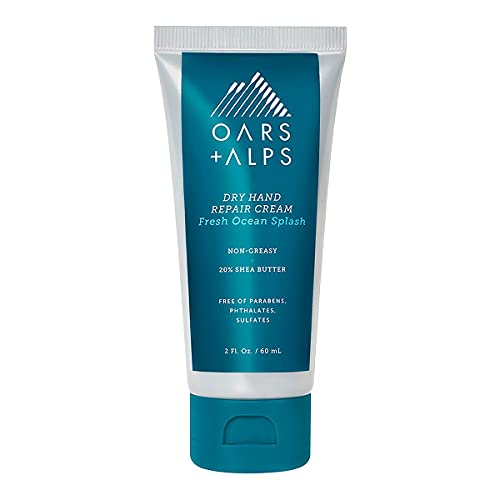
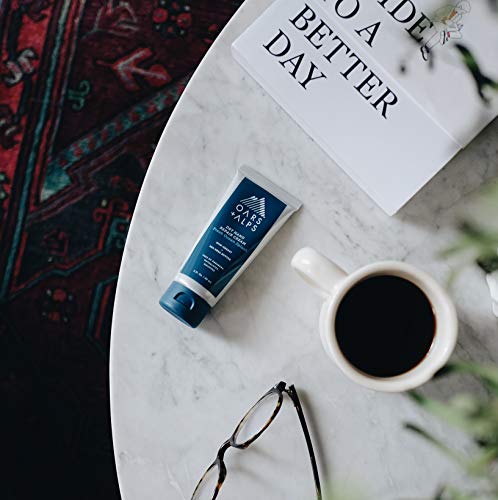
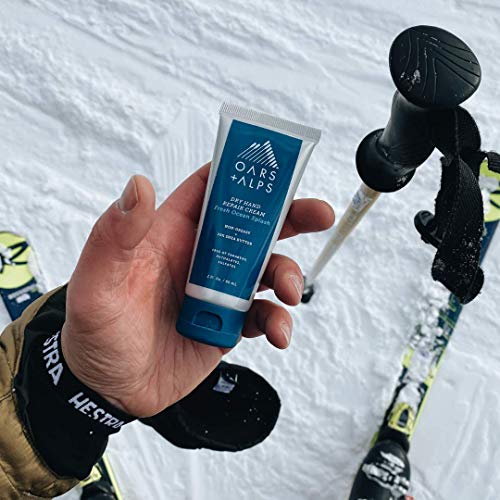
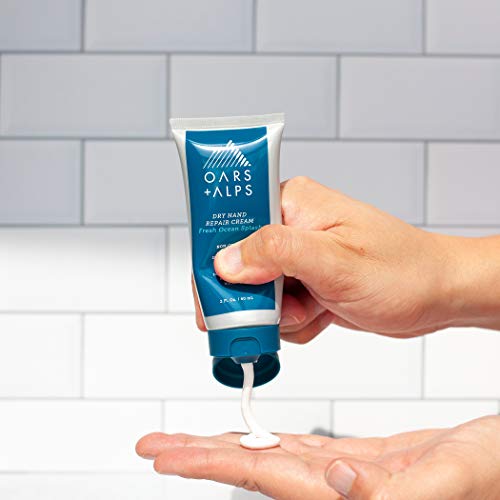
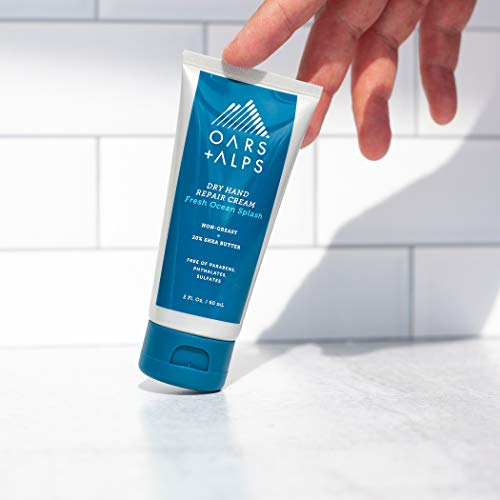
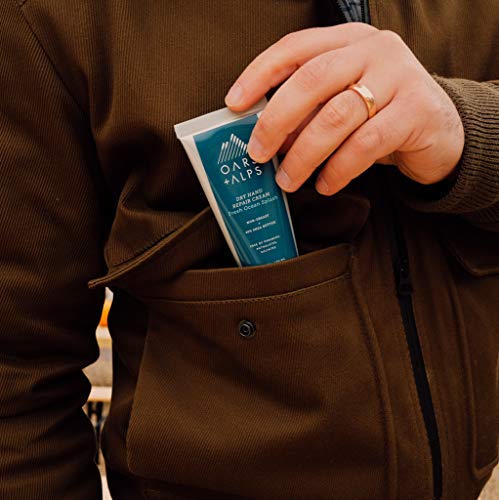
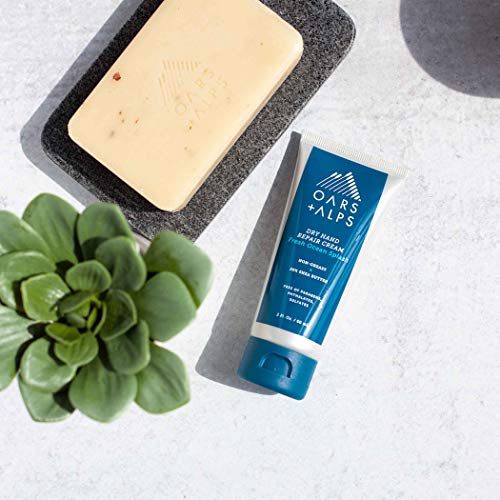
Oars + Alps Hand Cream - Deep Hydration, Dermatologist Tested, Fresh Ocean Splash - 2 Fl Oz


Hexyl Cinnamal
High RiskHexyl cinnamal is a naturally occurring and synthetic fragrance ingredient used primarily for its pleasant floral scent. It is commonly found in personal care and cosmetic products, contributing to their aromatic profiles.
Sustai Insights
Hexyl cinnamal provides a desirable fragrance in cosmetic formulations, enhancing product appeal. However, it is associated with a high allergenic potential, posing risks of skin irritation and sensitization. While it is not classified as a carcinogen or reproductive toxin, its use is restricted in certain regions. Overall, the ingredient presents a high risk due to its allergenic properties, necessitating caution in formulations, especially for sensitive populations.
Lilial
High RiskLilial (butylphenyl methylpropanal) is a synthetic fragrance ingredient commonly used in personal care and cosmetic products to provide a floral scent. It is known for its aromatic properties and is often included in formulations to enhance sensory appeal.
Sustai Insights
Lilial offers functional benefits as an effective fragrance component, enhancing the sensory experience of products. However, it poses significant health risks, including a high allergenic potential and concerns regarding endocrine disruption, despite lower risks for carcinogenicity and reproductive toxicity. Environmental risks include potential pollution and bioaccumulation. Regulatory bodies have raised concerns, resulting in high usage restrictions. Overall, the assessment indicates a high-risk level, suggesting caution in its use and consideration of safer or more sustainable alternatives.
Linalool
High RiskLinalool is a terpene commonly found in various plants, particularly in lavender and mint. It is primarily used in products for its fragrance and potential antimicrobial properties. Linalool is also utilized in formulations for its ability to enhance the sensory experience of personal care and household products.
Sustai Insights
Linalool offers functional benefits as a naturally occurring fragrance component and may exhibit antimicrobial properties. However, it presents high allergenic potential, with concerns about skin irritation and sensitization. Environmental risks include contamination issues, though it is not classified as a persistent pollutant. Regulatory bodies have noted the need for careful handling due to its allergenic nature. Overall, despite some beneficial attributes, the ingredient carries a high risk profile, warranting cautious use and consideration of safer alternatives.
Benzyl Salicylate
High RiskBenzyl salicylate is an ester of benzyl alcohol and salicylic acid, commonly used in personal care products as a fragrance component and UV filter. It is known for its ability to enhance product stability and provide a pleasant scent.
Sustai Insights
Benzyl salicylate offers functional benefits such as UV protection and fragrance enhancement. However, it is associated with a high allergenic potential and is categorized as a skin irritant, posing significant health risks. Environmental risks include its potential to act as a pollutant. Regulatory authorities have imposed restrictions on its use due to these concerns. Overall, it is assessed as high risk, necessitating caution in usage and consideration of safer alternatives.
Tocopheryl Acetate
Medium RiskTocopheryl acetate is a chemical compound that serves primarily as a form of Vitamin E. It is used in cosmetic and personal care products for its antioxidant properties and to enhance skin stability and moisture.
Sustai Insights
Tocopheryl acetate is valued for its functional benefits, including acting as an antioxidant and skin conditioning agent. It is generally considered to have low carcinogenicity and reproductive toxicity risk, although it poses a moderate concern for allergies. Environmental risks are minimal, with no significant pollutant or bioaccumulation potential noted. Regulatory bodies have not imposed significant restrictions. Safe usage practices should be followed, particularly regarding enhanced skin absorption. Alternatives like natural Vitamin E may provide similar benefits with potentially lower allergenic properties. Overall, this ingredient presents a medium risk assessment.
Dipropylene Glycol
Medium RiskDipropylene glycol is a small molecular weight glycol that is commonly used as a solvent, humectant, and skin-conditioning agent in various cosmetic and personal care products. It is derived from propylene glycol and is noted for its ability to enhance the texture and stability of formulations.
Sustai Insights
Dipropylene glycol serves effectively as a solvent and humectant, contributing to product texture and moisture retention. Environmental concerns are minimal, with low bioaccumulation potential and no significant pollution risks. While health risks such as carcinogenicity, allergies, and reproductive toxicity are low, regulatory agencies do not classify it as hazardous. Usage should be aligned with safety guidelines to mitigate risks, and alternatives such as glycerin or propylene glycol may offer comparable benefits with potentially fewer concerns. Overall, the risk level is assessed as medium.
Phenoxyethanol
Medium RiskPhenoxyethanol is a preservative used in cosmetics and personal care products to prevent microbial growth and extend shelf life. It is commonly found in formulations such as lotions, creams, and serums.
Sustai Insights
Phenoxyethanol serves effectively as a preservative, ensuring product stability and safety by inhibiting microbial growth. It is considered to have low health risks regarding carcinogenicity, allergies, and reproductive toxicity. However, moderate use restrictions exist, and regulatory bodies have advised caution in specific applications. Environmental concerns include its potential as a pollutant, although it is not highly bioaccumulative. Overall, the ingredient presents a medium risk level, with safe usage practices recommended and alternative preservatives available for those seeking greener options.
Dimethicone
Medium RiskDimethicone, also known as polymethylsiloxane, is a silicone-based polymer commonly used in personal care products for its smooth application and skin conditioning properties. It acts primarily as an emollient, providing a silky feel while forming a protective barrier on the skin.
Sustai Insights
Dimethicone provides functional benefits as an effective emollient and skin protectant, contributing to product stability and sensory attributes. It is considered low risk for carcinogenicity, allergies, and reproductive toxicity, but has moderate usage restrictions due to environmental persistence and bioaccumulation concerns. Regulatory bodies have issued advisories regarding its use in certain formulations. Overall, its risk level is assessed as medium, and users are advised to follow recommended usage practices. Alternatives like natural oils or butters may offer sustainable options.
Distarch Phosphate
Low RiskDistarch phosphate is a modified starch created through the esterification process of starch, primarily to enhance its stability and functionality in various formulations. It serves as a thickening agent, stabilizer, and emulsifier in food and cosmetic products, enabling improved texture and consistency.
Sustai Insights
Distarch phosphate offers functional benefits as a thickening and stabilizing agent, enhancing product texture without significant health risks, as it is classified as low for carcinogenicity, allergenic potential, and reproductive toxicity. Regulatory bodies, including Environment Canada, do not impose restrictions on its use. However, environmental risks appear minimal, with no concerns about bioaccumulation or pollution. Safe usage practices should be followed, but no significant alternatives are noted, leading to an overall low-risk assessment.
Xanthan Gum
Low RiskXanthan gum is a polysaccharide, a sugar-based compound produced by the fermentation of glucose or sucrose. It is commonly used as a thickening agent and stabilizer in various food and cosmetic products due to its ability to improve texture and prevent ingredient separation.
Sustai Insights
Xanthan gum serves effectively as a thickener and stabilizer, enhancing product texture and consistency. It is biodegradable and typically derived from renewable sources, supporting sustainability efforts. Health risks are minimal, with low concerns regarding carcinogenicity, allergies, and reproductive toxicity. Environmental impact is similarly low, posing no significant hazards. Regulatory agencies, including the FDA, regard it as safe for use, with no significant restrictions. Overall, xanthan gum is assessed as low risk, making it a suitable ingredient in formulations.
Water
Low RiskWater is a clear, colorless liquid essential for various biological processes. It serves as a solvent in formulations, facilitating the dissolution of other ingredients and enhancing product texture and application. Additionally, water plays a crucial role in hydration and is a key component in many cosmetic and personal care products.
Sustai Insights
Water is an effective solvent and hydrator, contributing to the texture and efficacy of formulations. It is biodegradable and generally regarded as safe, with low concerns regarding carcinogenicity, allergies, and reproductive toxicity. However, excessive water usage can lead to environmental concerns, particularly regarding resource depletion. Regulatory bodies do not impose restrictions on water use in cosmetics. Overall, the risks associated with water are low, making it a safe and essential ingredient.
Peg 10 Stearate
Low RiskPEG-10 stearate is a polyethylene glycol ester derived from stearic acid, commonly used as an emulsifier and surfactant in cosmetic and personal care products. It helps to stabilize formulations by mixing water and oils, enhancing texture and application.
Sustai Insights
PEG-10 stearate functions effectively as an emulsifier, aiding in product stability and texture. It is generally recognized as safe with low risks for cancer, allergies, and developmental toxicity. However, there are contamination concerns during production. Regulated under various standards, it poses minimal environmental risks and is not bioaccumulative. Overall, the ingredient is assessed as low risk, with no significant health or environmental hazards. For those seeking alternatives, consider plant-based emulsifiers which may offer similar functional benefits.
Isopentyldiol
Low RiskIsopentyldiol is a diol commonly used in cosmetic formulations. It functions primarily as a solvent and humectant, helping to retain moisture and improve the texture of products. It is valued for its ability to enhance the overall sensory experience of formulations.
Sustai Insights
Isopentyldiol offers functional benefits as a solvent and humectant, enhancing product texture and moisture retention. Scientific evaluations indicate low health risks, with negligible concerns regarding carcinogenicity, allergies, or reproductive toxicity. Environmentally, it presents minimal hazards and is not bioaccumulative. Regulatory assessments do not highlight significant restrictions, resulting in an overall low risk classification. For safe usage, it is advisable to follow recommended concentrations in formulations. Alternatives include other diols like propylene glycol or butylene glycol, which may provide similar benefits.
Butyrospermum Parkii (Shea) Butter
Low RiskButyrospermum parkii (shea) butter is a vegetable fat derived from the nuts of the shea tree. It is commonly used in cosmetic formulations for its emollient properties, providing moisture and improving skin texture. Additionally, shea butter is known for its ability to enhance the stability of products and deliver a creamy texture.
Sustai Insights
Shea butter offers functional benefits as an effective moisturizer, enhancing skin barrier function and texture. It is sustainably sourced and biodegradable, contributing to eco-friendliness. Health-wise, it is associated with low risks for carcinogenicity, allergies, and reproductive toxicity. Environmental impacts are minimal, with no significant pollutant potential identified. Regulatory assessments indicate no current restrictions. Overall, the ingredient presents a low risk, making it a favorable choice in cosmetic formulations.
Propanediol
Low RiskPropanediol is a glycol compound commonly used in cosmetic and personal care products as a solvent, humectant, and skin-conditioning agent. It serves to enhance the texture and moisture retention of formulations, contributing to overall product efficacy.
Sustai Insights
Propanediol offers functional benefits such as effective moisture retention and improved product application. It is considered low-risk in terms of health concerns, with minimal associations with carcinogenicity, allergies, or reproductive toxicity. Environmentally, it has low pollutant potential and is not bioaccumulative. Regulatory bodies have not placed restrictions on its use. Despite concerns regarding enhanced skin absorption and potential endocrine disruption, the overall assessment indicates low risk. Safe usage practices should be followed, and alternatives like glycerin or other plant-based humectants can be considered.
Cetearyl Alcohol
Low RiskCetearyl alcohol is a mixture of cetyl and stearyl alcohol, primarily used as an emulsifier and thickener in cosmetic formulations. It helps stabilize products, improve texture, and enhance moisturizing properties, making it common in creams and lotions.
Sustai Insights
Cetearyl alcohol offers functional benefits as an effective emulsifier and skin-conditioning agent, contributing to product stability and texture. It is generally recognized as safe, with low concerns for carcinogenicity, allergies, or reproductive toxicity. Environmental risks are minimal, as it is biodegradable and has low pollutant potential. Regulatory bodies have not imposed significant restrictions on its use. Overall, cetearyl alcohol is assessed to carry low risk, making it a suitable ingredient choice in cosmetic products.
Caprylyl Glycol
Low RiskCaprylyl glycol (1,2-octanediol) is a multifunctional cosmetic ingredient primarily used as a skin-conditioning agent and preservative. It is derived from caprylic acid, a fatty acid found in coconut oil, and is commonly included in personal care products for its moisturizing properties.
Sustai Insights
Caprylyl glycol offers functional benefits such as acting as an effective humectant and preservative, enhancing skin hydration and product stability. It is considered to have low health risks, with no significant concerns regarding carcinogenicity, allergies, or reproductive toxicity. Environmentally, it poses minimal risks, being non-bioaccumulative and not linked to pollution. Regulatory assessments affirm its safety, with no major advisories against its use. Overall, the ingredient is assessed to have a low risk, making it a suitable choice in cosmetic formulations.
Cocos Nucifera (Coconut) Oil
Low RiskCocos Nucifera (Coconut) Oil is derived from the kernels of the coconut palm. It is primarily used in cosmetic formulations for its emollient and moisturizing properties, making it suitable for skin and hair care products.
Sustai Insights
Coconut oil serves as an effective moisturizer and emollient, promoting skin hydration and softness. It is sustainably sourced and biodegradable. Health risks are minimal, with low concerns regarding carcinogenicity, allergens, and reproductive toxicity. Environmental impact is also low, as it does not contribute significantly to pollution or bioaccumulation. Regulatory bodies have not issued restrictions on its use. Overall, coconut oil presents a low risk for health and environmental concerns, making it a safe ingredient in cosmetic products.
Coco Caprylate/Caprate
Low RiskCoco-caprylate/caprate is a mixture of esters derived from coconut oil, primarily used as an emollient and skin-conditioning agent in cosmetic formulations. It enhances the texture and spreadability of products, providing a silky feel on the skin without leaving a greasy residue.
Sustai Insights
Coco-caprylate/caprate serves effectively as an emollient, offering a silky texture to formulations while being biodegradable and sourced sustainably from coconut oil. Health risks are minimal, with low concerns regarding carcinogenicity, allergies, or reproductive toxicity. Environmental risks are also considered low, with no significant pollutant or bioaccumulation potential. Regulatory bodies have not imposed significant restrictions on its use, indicating a favorable safety profile. Overall, the ingredient is assessed to have a low risk, and safer alternatives are limited but may include other natural emollients.
Tocopheryl Acetate
Medium RiskTocopheryl acetate is a chemical compound that serves primarily as a form of Vitamin E. It is used in cosmetic and personal care products for its antioxidant properties and to enhance skin stability and moisture.
Sustai Insights
Tocopheryl acetate is valued for its functional benefits, including acting as an antioxidant and skin conditioning agent. It is generally considered to have low carcinogenicity and reproductive toxicity risk, although it poses a moderate concern for allergies. Environmental risks are minimal, with no significant pollutant or bioaccumulation potential noted. Regulatory bodies have not imposed significant restrictions. Safe usage practices should be followed, particularly regarding enhanced skin absorption. Alternatives like natural Vitamin E may provide similar benefits with potentially lower allergenic properties. Overall, this ingredient presents a medium risk assessment.
Distarch Phosphate
Low RiskDistarch phosphate is a modified starch created through the esterification process of starch, primarily to enhance its stability and functionality in various formulations. It serves as a thickening agent, stabilizer, and emulsifier in food and cosmetic products, enabling improved texture and consistency.
Sustai Insights
Distarch phosphate offers functional benefits as a thickening and stabilizing agent, enhancing product texture without significant health risks, as it is classified as low for carcinogenicity, allergenic potential, and reproductive toxicity. Regulatory bodies, including Environment Canada, do not impose restrictions on its use. However, environmental risks appear minimal, with no concerns about bioaccumulation or pollution. Safe usage practices should be followed, but no significant alternatives are noted, leading to an overall low-risk assessment.
Xanthan Gum
Low RiskXanthan gum is a polysaccharide, a sugar-based compound produced by the fermentation of glucose or sucrose. It is commonly used as a thickening agent and stabilizer in various food and cosmetic products due to its ability to improve texture and prevent ingredient separation.
Sustai Insights
Xanthan gum serves effectively as a thickener and stabilizer, enhancing product texture and consistency. It is biodegradable and typically derived from renewable sources, supporting sustainability efforts. Health risks are minimal, with low concerns regarding carcinogenicity, allergies, and reproductive toxicity. Environmental impact is similarly low, posing no significant hazards. Regulatory agencies, including the FDA, regard it as safe for use, with no significant restrictions. Overall, xanthan gum is assessed as low risk, making it a suitable ingredient in formulations.
Dipropylene Glycol
Medium RiskDipropylene glycol is a small molecular weight glycol that is commonly used as a solvent, humectant, and skin-conditioning agent in various cosmetic and personal care products. It is derived from propylene glycol and is noted for its ability to enhance the texture and stability of formulations.
Sustai Insights
Dipropylene glycol serves effectively as a solvent and humectant, contributing to product texture and moisture retention. Environmental concerns are minimal, with low bioaccumulation potential and no significant pollution risks. While health risks such as carcinogenicity, allergies, and reproductive toxicity are low, regulatory agencies do not classify it as hazardous. Usage should be aligned with safety guidelines to mitigate risks, and alternatives such as glycerin or propylene glycol may offer comparable benefits with potentially fewer concerns. Overall, the risk level is assessed as medium.
Water
Low RiskWater is a clear, colorless liquid essential for various biological processes. It serves as a solvent in formulations, facilitating the dissolution of other ingredients and enhancing product texture and application. Additionally, water plays a crucial role in hydration and is a key component in many cosmetic and personal care products.
Sustai Insights
Water is an effective solvent and hydrator, contributing to the texture and efficacy of formulations. It is biodegradable and generally regarded as safe, with low concerns regarding carcinogenicity, allergies, and reproductive toxicity. However, excessive water usage can lead to environmental concerns, particularly regarding resource depletion. Regulatory bodies do not impose restrictions on water use in cosmetics. Overall, the risks associated with water are low, making it a safe and essential ingredient.
Peg 10 Stearate
Low RiskPEG-10 stearate is a polyethylene glycol ester derived from stearic acid, commonly used as an emulsifier and surfactant in cosmetic and personal care products. It helps to stabilize formulations by mixing water and oils, enhancing texture and application.
Sustai Insights
PEG-10 stearate functions effectively as an emulsifier, aiding in product stability and texture. It is generally recognized as safe with low risks for cancer, allergies, and developmental toxicity. However, there are contamination concerns during production. Regulated under various standards, it poses minimal environmental risks and is not bioaccumulative. Overall, the ingredient is assessed as low risk, with no significant health or environmental hazards. For those seeking alternatives, consider plant-based emulsifiers which may offer similar functional benefits.
Isopentyldiol
Low RiskIsopentyldiol is a diol commonly used in cosmetic formulations. It functions primarily as a solvent and humectant, helping to retain moisture and improve the texture of products. It is valued for its ability to enhance the overall sensory experience of formulations.
Sustai Insights
Isopentyldiol offers functional benefits as a solvent and humectant, enhancing product texture and moisture retention. Scientific evaluations indicate low health risks, with negligible concerns regarding carcinogenicity, allergies, or reproductive toxicity. Environmentally, it presents minimal hazards and is not bioaccumulative. Regulatory assessments do not highlight significant restrictions, resulting in an overall low risk classification. For safe usage, it is advisable to follow recommended concentrations in formulations. Alternatives include other diols like propylene glycol or butylene glycol, which may provide similar benefits.
Hexyl Cinnamal
High RiskHexyl cinnamal is a naturally occurring and synthetic fragrance ingredient used primarily for its pleasant floral scent. It is commonly found in personal care and cosmetic products, contributing to their aromatic profiles.
Sustai Insights
Hexyl cinnamal provides a desirable fragrance in cosmetic formulations, enhancing product appeal. However, it is associated with a high allergenic potential, posing risks of skin irritation and sensitization. While it is not classified as a carcinogen or reproductive toxin, its use is restricted in certain regions. Overall, the ingredient presents a high risk due to its allergenic properties, necessitating caution in formulations, especially for sensitive populations.
Butyrospermum Parkii (Shea) Butter
Low RiskButyrospermum parkii (shea) butter is a vegetable fat derived from the nuts of the shea tree. It is commonly used in cosmetic formulations for its emollient properties, providing moisture and improving skin texture. Additionally, shea butter is known for its ability to enhance the stability of products and deliver a creamy texture.
Sustai Insights
Shea butter offers functional benefits as an effective moisturizer, enhancing skin barrier function and texture. It is sustainably sourced and biodegradable, contributing to eco-friendliness. Health-wise, it is associated with low risks for carcinogenicity, allergies, and reproductive toxicity. Environmental impacts are minimal, with no significant pollutant potential identified. Regulatory assessments indicate no current restrictions. Overall, the ingredient presents a low risk, making it a favorable choice in cosmetic formulations.
Propanediol
Low RiskPropanediol is a glycol compound commonly used in cosmetic and personal care products as a solvent, humectant, and skin-conditioning agent. It serves to enhance the texture and moisture retention of formulations, contributing to overall product efficacy.
Sustai Insights
Propanediol offers functional benefits such as effective moisture retention and improved product application. It is considered low-risk in terms of health concerns, with minimal associations with carcinogenicity, allergies, or reproductive toxicity. Environmentally, it has low pollutant potential and is not bioaccumulative. Regulatory bodies have not placed restrictions on its use. Despite concerns regarding enhanced skin absorption and potential endocrine disruption, the overall assessment indicates low risk. Safe usage practices should be followed, and alternatives like glycerin or other plant-based humectants can be considered.
Phenoxyethanol
Medium RiskPhenoxyethanol is a preservative used in cosmetics and personal care products to prevent microbial growth and extend shelf life. It is commonly found in formulations such as lotions, creams, and serums.
Sustai Insights
Phenoxyethanol serves effectively as a preservative, ensuring product stability and safety by inhibiting microbial growth. It is considered to have low health risks regarding carcinogenicity, allergies, and reproductive toxicity. However, moderate use restrictions exist, and regulatory bodies have advised caution in specific applications. Environmental concerns include its potential as a pollutant, although it is not highly bioaccumulative. Overall, the ingredient presents a medium risk level, with safe usage practices recommended and alternative preservatives available for those seeking greener options.
Dimethicone
Medium RiskDimethicone, also known as polymethylsiloxane, is a silicone-based polymer commonly used in personal care products for its smooth application and skin conditioning properties. It acts primarily as an emollient, providing a silky feel while forming a protective barrier on the skin.
Sustai Insights
Dimethicone provides functional benefits as an effective emollient and skin protectant, contributing to product stability and sensory attributes. It is considered low risk for carcinogenicity, allergies, and reproductive toxicity, but has moderate usage restrictions due to environmental persistence and bioaccumulation concerns. Regulatory bodies have issued advisories regarding its use in certain formulations. Overall, its risk level is assessed as medium, and users are advised to follow recommended usage practices. Alternatives like natural oils or butters may offer sustainable options.
Cetearyl Alcohol
Low RiskCetearyl alcohol is a mixture of cetyl and stearyl alcohol, primarily used as an emulsifier and thickener in cosmetic formulations. It helps stabilize products, improve texture, and enhance moisturizing properties, making it common in creams and lotions.
Sustai Insights
Cetearyl alcohol offers functional benefits as an effective emulsifier and skin-conditioning agent, contributing to product stability and texture. It is generally recognized as safe, with low concerns for carcinogenicity, allergies, or reproductive toxicity. Environmental risks are minimal, as it is biodegradable and has low pollutant potential. Regulatory bodies have not imposed significant restrictions on its use. Overall, cetearyl alcohol is assessed to carry low risk, making it a suitable ingredient choice in cosmetic products.
Lilial
High RiskLilial (butylphenyl methylpropanal) is a synthetic fragrance ingredient commonly used in personal care and cosmetic products to provide a floral scent. It is known for its aromatic properties and is often included in formulations to enhance sensory appeal.
Sustai Insights
Lilial offers functional benefits as an effective fragrance component, enhancing the sensory experience of products. However, it poses significant health risks, including a high allergenic potential and concerns regarding endocrine disruption, despite lower risks for carcinogenicity and reproductive toxicity. Environmental risks include potential pollution and bioaccumulation. Regulatory bodies have raised concerns, resulting in high usage restrictions. Overall, the assessment indicates a high-risk level, suggesting caution in its use and consideration of safer or more sustainable alternatives.
Linalool
High RiskLinalool is a terpene commonly found in various plants, particularly in lavender and mint. It is primarily used in products for its fragrance and potential antimicrobial properties. Linalool is also utilized in formulations for its ability to enhance the sensory experience of personal care and household products.
Sustai Insights
Linalool offers functional benefits as a naturally occurring fragrance component and may exhibit antimicrobial properties. However, it presents high allergenic potential, with concerns about skin irritation and sensitization. Environmental risks include contamination issues, though it is not classified as a persistent pollutant. Regulatory bodies have noted the need for careful handling due to its allergenic nature. Overall, despite some beneficial attributes, the ingredient carries a high risk profile, warranting cautious use and consideration of safer alternatives.
Caprylyl Glycol
Low RiskCaprylyl glycol (1,2-octanediol) is a multifunctional cosmetic ingredient primarily used as a skin-conditioning agent and preservative. It is derived from caprylic acid, a fatty acid found in coconut oil, and is commonly included in personal care products for its moisturizing properties.
Sustai Insights
Caprylyl glycol offers functional benefits such as acting as an effective humectant and preservative, enhancing skin hydration and product stability. It is considered to have low health risks, with no significant concerns regarding carcinogenicity, allergies, or reproductive toxicity. Environmentally, it poses minimal risks, being non-bioaccumulative and not linked to pollution. Regulatory assessments affirm its safety, with no major advisories against its use. Overall, the ingredient is assessed to have a low risk, making it a suitable choice in cosmetic formulations.
Cocos Nucifera (Coconut) Oil
Low RiskCocos Nucifera (Coconut) Oil is derived from the kernels of the coconut palm. It is primarily used in cosmetic formulations for its emollient and moisturizing properties, making it suitable for skin and hair care products.
Sustai Insights
Coconut oil serves as an effective moisturizer and emollient, promoting skin hydration and softness. It is sustainably sourced and biodegradable. Health risks are minimal, with low concerns regarding carcinogenicity, allergens, and reproductive toxicity. Environmental impact is also low, as it does not contribute significantly to pollution or bioaccumulation. Regulatory bodies have not issued restrictions on its use. Overall, coconut oil presents a low risk for health and environmental concerns, making it a safe ingredient in cosmetic products.
Benzyl Salicylate
High RiskBenzyl salicylate is an ester of benzyl alcohol and salicylic acid, commonly used in personal care products as a fragrance component and UV filter. It is known for its ability to enhance product stability and provide a pleasant scent.
Sustai Insights
Benzyl salicylate offers functional benefits such as UV protection and fragrance enhancement. However, it is associated with a high allergenic potential and is categorized as a skin irritant, posing significant health risks. Environmental risks include its potential to act as a pollutant. Regulatory authorities have imposed restrictions on its use due to these concerns. Overall, it is assessed as high risk, necessitating caution in usage and consideration of safer alternatives.
Coco Caprylate/Caprate
Low RiskCoco-caprylate/caprate is a mixture of esters derived from coconut oil, primarily used as an emollient and skin-conditioning agent in cosmetic formulations. It enhances the texture and spreadability of products, providing a silky feel on the skin without leaving a greasy residue.
Sustai Insights
Coco-caprylate/caprate serves effectively as an emollient, offering a silky texture to formulations while being biodegradable and sourced sustainably from coconut oil. Health risks are minimal, with low concerns regarding carcinogenicity, allergies, or reproductive toxicity. Environmental risks are also considered low, with no significant pollutant or bioaccumulation potential. Regulatory bodies have not imposed significant restrictions on its use, indicating a favorable safety profile. Overall, the ingredient is assessed to have a low risk, and safer alternatives are limited but may include other natural emollients.
Experience the soothing power of Oars + Alps Dry Hand Repair Cream. Formulated with 20% Shea Butter, this dermatologist-tested hand cream provides intense hydration without greasiness, making it perfect for everyday use.
- Repair and Hydrate: Enriched with Shea Butter and Coconut Oil, this cream deeply penetrates to heal dry skin, restoring moisture and softness.
- Clean Ingredients: Made with premium, clean components, this hand cream is free from parabens, sulfates, and animal cruelty, ensuring safety and health for your skin.
- Refreshing Scent: Delight in the best-selling Fresh Ocean Splash fragrance, a harmonious blend of Cedarwood, Lime, and Fresh Greens, leaving hands smelling cool and sophisticated.
- Travel-Friendly: At 2 oz., this compact hand cream fits easily in bags or pockets, making it ideal for on-the-go hydration whether at work or the gym.
- Gentle and Effective: Suitable for all skin types, it combats free radicals and reduces redness, leaving hands looking and feeling their best.
Subscribe & Save with Sustai
- Best Price Guarantee: Always enjoy the lowest prices on sustainable home essentials.
- No Surprises: We’ll notify you before shipping. No hidden fees, ever.
- You’re in Charge: Change, pause, or cancel your subscription anytime with ease.
- Eco-Friendly Deliveries: Our grouped shipments mean less packaging and lower emissions.
Join us on a sustainable journey. Special offers for a limited time! Prices and promotions may change.
Recommended Products
Experience the soothing power of Oars + Alps Dry Hand Repair Cream. Formulated with 20% Shea Butter, this dermatologist-tested hand cream provides intense hydration without greasiness, making it perfect for everyday use.
- Repair and Hydrate: Enriched with Shea Butter and Coconut Oil, this cream deeply penetrates to heal dry skin, restoring moisture and softness.
- Clean Ingredients: Made with premium, clean components, this hand cream is free from parabens, sulfates, and animal cruelty, ensuring safety and health for your skin.
- Refreshing Scent: Delight in the best-selling Fresh Ocean Splash fragrance, a harmonious blend of Cedarwood, Lime, and Fresh Greens, leaving hands smelling cool and sophisticated.
- Travel-Friendly: At 2 oz., this compact hand cream fits easily in bags or pockets, making it ideal for on-the-go hydration whether at work or the gym.
- Gentle and Effective: Suitable for all skin types, it combats free radicals and reduces redness, leaving hands looking and feeling their best.

You can have at most 2 Sustainable Steals products in your cart
Customer Reviews
Customers’ View
Customers appreciate the effectiveness of the Oars + Alps Hand Cream in providing intense hydration without a greasy feel. Many users note its quick absorption and gentle formulation, making it suitable for daily use. Common praises include the refreshing Fresh Ocean Splash scent, which adds to the overall experience without being overpowering. Reviewers highlight the product's quality, with several mentioning its success in alleviating dryness over time. Additionally, the clean beauty aspect resonates well with environmentally and health-conscious consumers, as it is dermatologist tested and free from harmful additives. Overall, customers find this hand cream to be a reliable option for maintaining soft, moisturized hands.
AI-generated from the text of customer reviewsThis product has no reviews yet.




